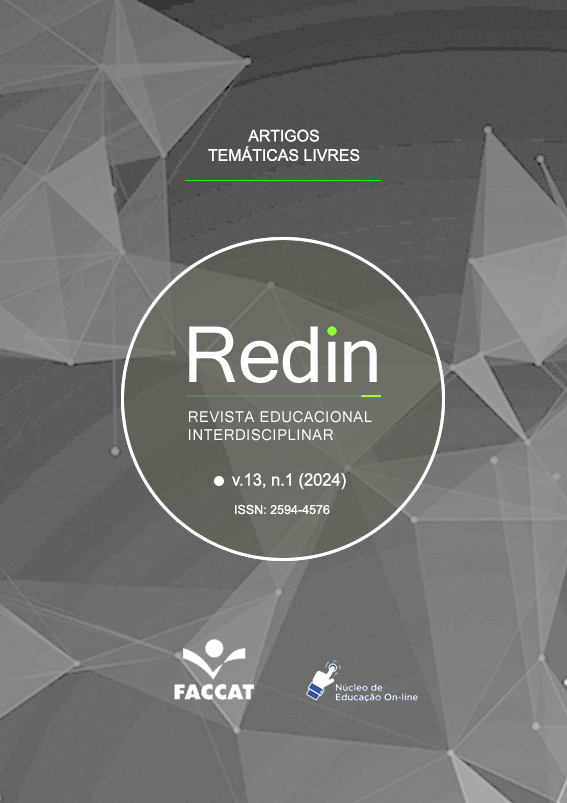A evolução das TICs, sua aplicação em uma disciplina no ensino superior semipresencial e a avaliação de um grupo de estudantes
Resumo
Esse estudo apresenta a evolução do uso das Tecnologias de Informação e Comunicação (TICs) em uma disciplina do ensino superior semipresencial, os recursos assíncronos e síncronos (presenciais e online) usados. Foi aplicado um questionário de preenchimento opcional entre os discentes a fim de verificar seu engajamento aos recursos oferecidos, considerando os aspectos comportamental, afetivo e cognitivo. Foi verificado que os alunos valorizaram as aulas práticas presenciais, bem como as interações síncronas com tutores a distância e presenciais, demonstrando a importância desse contato para o aprendizado. Outro ponto importante analisado é que a organização e engajamento dos estudantes aos estudos semanais, aderindo às propostas pedagógicas da disciplina, favoreceu o bom desempenho dos alunos.
Palavras-chave: Sala de aula invertida; Recursos síncronos; Recursos assíncronos; Avaliação de Desempenho; EaD
Referências
BARDIN, L. Análise de Conteúdo. 2ª reimp. 1. Ed. São Paulo: EDIÇÕES 70 LDA/ALMEDINA BRASIL, 2012.
BIELSCHOWSKY, C.E. Qualidade na Educação Superior a distância no Brasil: onde estamos, para onde vamos? Rev. EaD em Foco. 2018: 8(1): e709.
BIELSCHOWSKY, C.E. & MASUDA, M. Diplomação na Educação Superior a distância. Em Rede Revista de Educação a distância. v.5 n.1 2018.
FOZDAR, B.I.; KUMAR, L.S.; KANNAN, S. A survey of study on the reasons responsible for student dropout from the bachelor of Science Programme at Indira Gandhi National Open University, India. The International Rewiew of Researchin Open and distance Learning, v. 7, n. 3, 2006 disponível em https://www.irrodl.org/index.php/irrodl/article/view/291/755. Acesso em 28/10/2023.
FREIRE, P. Educação e Mudança.29 ed. São Paulo: Editora Paz e Terra S/A, 2006.
HALVERSON, L.R.; GRAHAM, C.R. Learner engagement in Blended Learning Environments: a conceptual framework. Online Learning Journal v. 23, n. 2 p. 145-178. 2019.
HEILPORN, G.; LAKHAL, S.; BÉLISLE, M. An examination of teachers’ strategies to foster student engagement in blended learning in higher education. International Journal of Educational Technology in Higher Education v18 n 21 2021.
LUDKE, M; ANDRÉ, M.E.D.A. Pesquisa em educação: Abordagens qualitativas. 2. Ed Rio de Janeiro: E.P.U, 2013.
MARTINELLI, J.; BENDER FILHO,R.; VIEIRA,K.M. Evasão na Universidade Aberta do Brasil: O Caso da Universidade Federal de Santa Maria. EaD em Foco, v. 13, n. 1, e2014, 2023. doi: https://doi.org/10.18264/eadf.v13i1.2014
PAIVA, M.R.F; PARENTE, J.R.F; BRANDÃO, I.R.; QUEIROZ, A.H.B. Metodologias ativas de ensino-aprendizagem: revisão integrativa. SANARE, Sobral. v.15 n. 2 p. 145-153, 2016.
ROSSE, C.G.; ARAGON, G.T.; ALBUQUERQUE, C.F.S.; DE OLIVEIRA, M.F.A. Uma análise sobre a utilização de webconferência na educação a distância no Brasil. REPPE. Cornélio Procópio, v.7 n.1 p. 247-262, 2023.
ROSSE, C.G.; ARAGON, G.T.; DE OLIVEIRA, M.F.A. Webconferência: o que diz um grupo de estudantes do ensino superior a distância. EaD em Foco. V 10 e 1038 2020.
SILVA,C.G.; FIGUEIREDO,V.F. Ambiente virtual de aprendizagem: comunicação, interação e afetividade na EAD. Revista Aprendizagem em EAD. Taguatinga, DF, v.1 p. 1-16. 2012.
VALENTE, J.A. Blended learning e as mudanças no ensino superior: a proposta da sala de aula invertida. Educar em Revista, Curitiba. 2014: Ed Esp. 4 p. 79-97.


